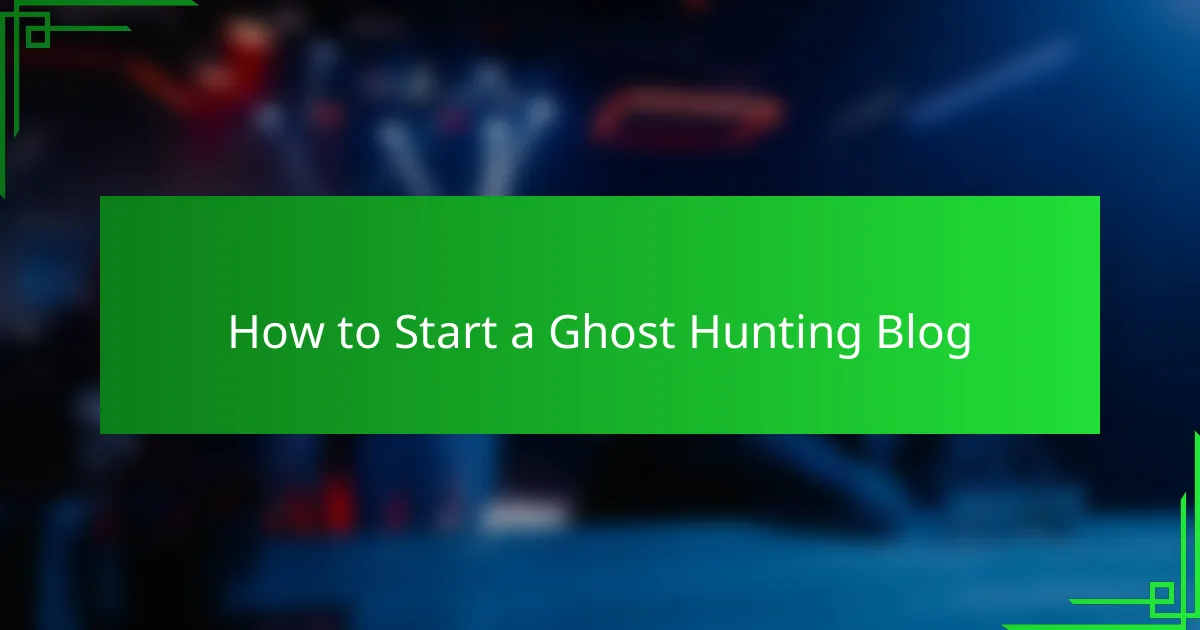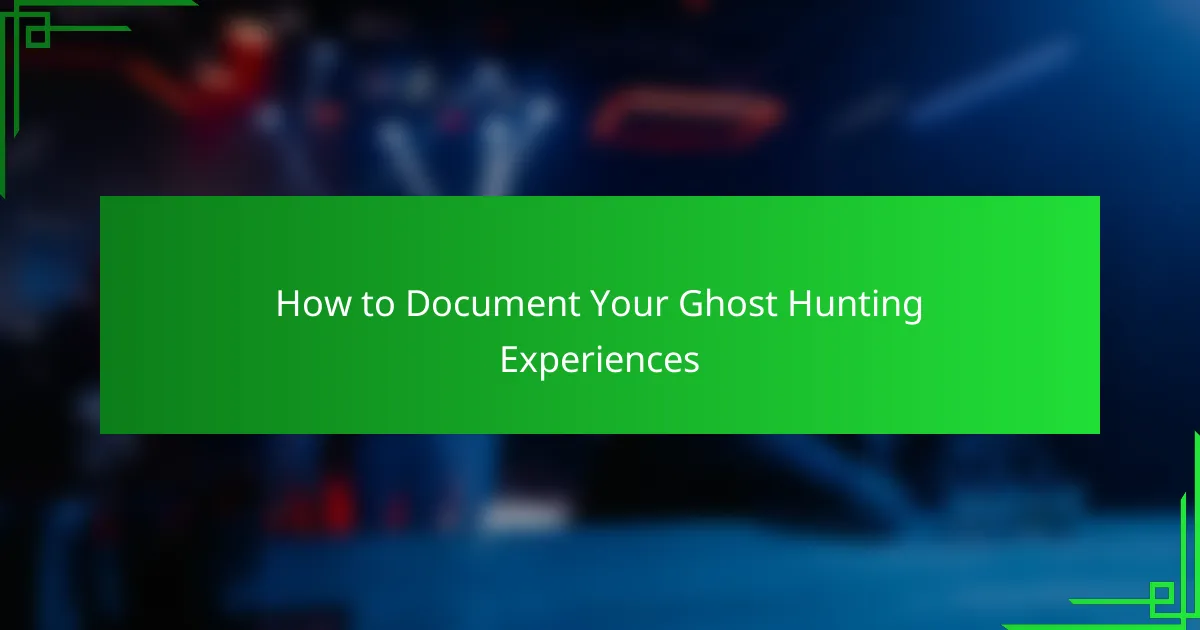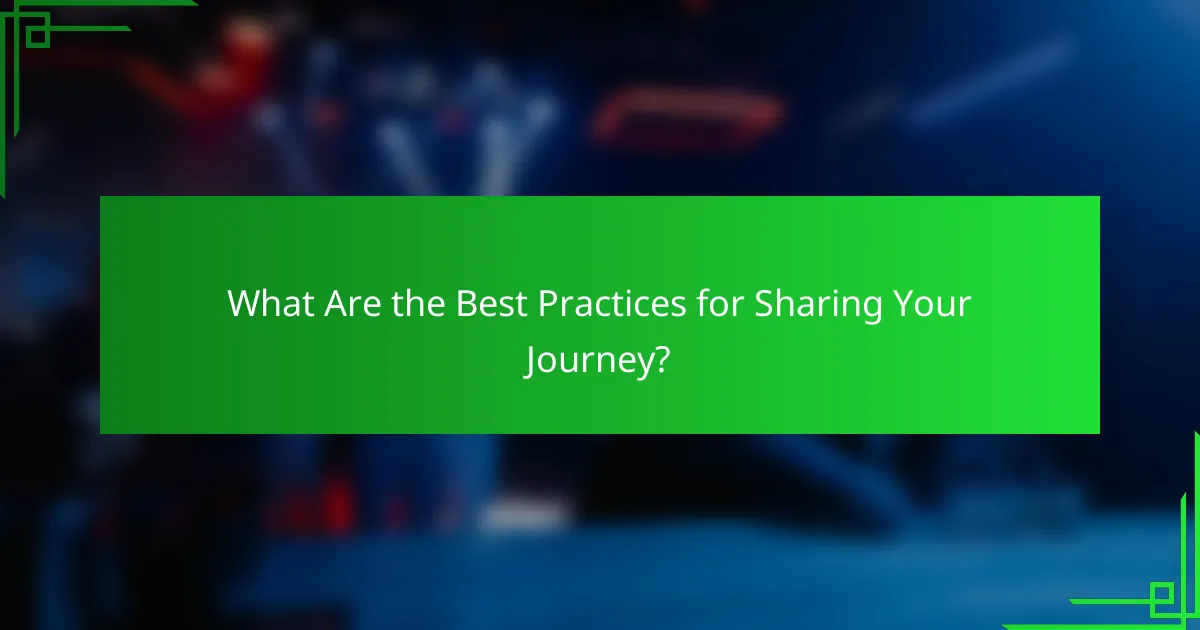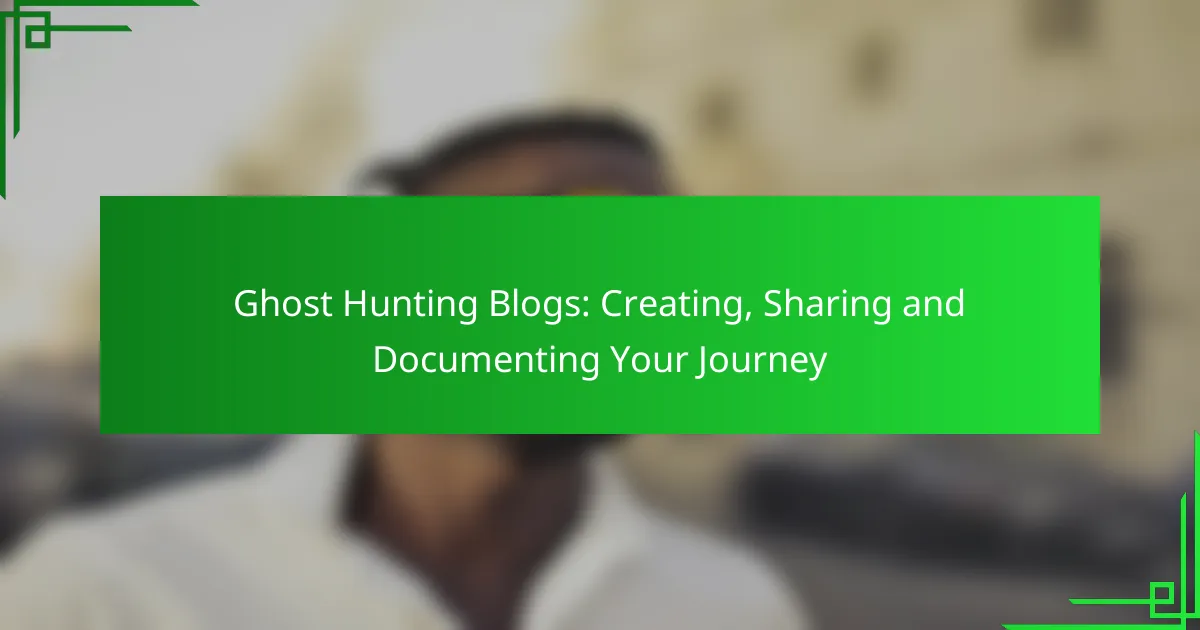Starting a ghost hunting blog is an exciting way to share your paranormal experiences and connect with fellow enthusiasts. By focusing on your unique perspective and documenting your investigations, you can engage readers and create a community around your shared passion for the supernatural.

How to Start a Ghost Hunting Blog
Starting a ghost hunting blog involves sharing your experiences and insights about paranormal investigations while engaging with a community of like-minded enthusiasts. Focus on your unique perspective and the stories you want to tell to attract readers.
Choosing a blogging platform
Selecting the right blogging platform is crucial for your ghost hunting blog’s success. Popular options include WordPress, Blogger, and Wix, each offering different levels of customization and ease of use.
Consider your technical skills and the features you need, such as multimedia support for photos and videos from your ghost hunts. WordPress is often favored for its flexibility, while Wix is user-friendly for beginners.
Defining your niche
Defining your niche helps you stand out in the crowded ghost hunting community. You might focus on specific types of hauntings, historical locations, or even ghost hunting gear reviews.
Think about what excites you most about ghost hunting and how you can share that passion with your audience. This will guide your content and attract a dedicated readership.
Setting up your blog
Setting up your blog involves choosing a domain name that reflects your niche and registering it with a hosting service. Make sure the name is memorable and relevant to your ghost hunting theme.
Once your blog is live, customize its design to create an inviting atmosphere. Use images from your investigations and consider adding features like a contact form or social media links to engage with your audience.
Creating engaging content
Creating engaging content is key to keeping your readers interested. Share detailed accounts of your ghost hunting experiences, including the locations, tools used, and any findings.
Incorporate multimedia elements like photos, videos, and audio recordings to enhance your storytelling. Regularly update your blog with new posts to maintain reader interest and encourage return visits.
Promoting your blog
Promoting your blog effectively can help you reach a wider audience. Utilize social media platforms like Facebook, Instagram, and Twitter to share your posts and connect with fellow ghost hunting enthusiasts.
Consider joining online forums or local ghost hunting groups to share your blog and engage with potential readers. Collaborating with other bloggers or participating in ghost hunting events can also increase your visibility.

What Equipment Do You Need for Ghost Hunting?
To effectively engage in ghost hunting, you need a variety of specialized equipment designed to detect paranormal activity. Essential tools can range from basic items like flashlights to advanced devices such as EMF meters and spirit boxes.
Essential ghost hunting tools
Key tools for ghost hunting include EMF meters, which measure electromagnetic fields that may indicate paranormal presence, and digital voice recorders for capturing potential EVP (Electronic Voice Phenomena). Additionally, infrared thermometers can help detect temperature fluctuations often associated with ghostly encounters.
Other useful equipment includes night vision cameras for low-light conditions and motion sensors to alert you to unexplained movements. A sturdy flashlight is also crucial for navigating dark locations safely.
Recommended brands for equipment
When selecting ghost hunting equipment, consider reputable brands known for reliability. For EMF meters, brands like K-II and Ghost Meter are popular among enthusiasts. For voice recorders, Zoom and Tascam offer high-quality options that capture clear audio.
For cameras, look into brands like Sony or Canon, which provide excellent low-light performance. Additionally, brands like FLIR are well-regarded for thermal imaging cameras that can reveal temperature changes indicative of paranormal activity.
Budget-friendly options
If you’re on a budget, there are several affordable ghost hunting tools available. Basic EMF meters can be found for under $50, and many digital voice recorders are available in the $30-$100 range, offering good quality without breaking the bank.
For those starting out, consider using smartphone apps designed for ghost hunting, which can provide basic functionalities like EMF detection and EVP recording at little to no cost. Always check user reviews to ensure the app’s effectiveness before relying on it during investigations.

How to Document Your Ghost Hunting Experiences
Documenting your ghost hunting experiences involves capturing your findings, feelings, and insights in a structured way. This process not only helps you reflect on your adventures but also allows you to share your journey with others who share your interest.
Effective storytelling techniques
To engage your audience, use storytelling techniques that highlight the emotional and thrilling aspects of your ghost hunting experiences. Start with a hook that captures attention, such as an eerie encounter or an unexpected discovery. Build tension by describing the setting and your feelings during the hunt.
Incorporate character development by introducing team members or local legends that add depth to your narrative. Use vivid descriptions to paint a picture of the environment, making readers feel as if they are experiencing the hunt alongside you.
Using multimedia for documentation
Multimedia elements like photos, videos, and audio recordings can significantly enhance your ghost hunting documentation. Capture high-quality images of locations, equipment, and any paranormal phenomena you encounter. Video footage can provide a dynamic view of your investigations, allowing viewers to see the atmosphere and your reactions in real-time.
Consider creating audio recordings of your thoughts during the hunt or interviews with team members. This adds a personal touch and can help convey the excitement and tension of the experience. Ensure that all multimedia is well-organized and easily accessible for future reference or sharing.
Creating a content calendar
A content calendar helps you plan and organize your ghost hunting documentation effectively. Start by outlining key dates for your hunts, potential locations, and themes you want to explore. This will keep your content consistent and engaging for your audience.
Include deadlines for editing and publishing your stories, as well as time for gathering and processing multimedia. Regularly review and adjust your calendar to accommodate new opportunities or changes in your ghost hunting schedule. This proactive approach ensures you maintain a steady flow of content and keeps your audience engaged.

What Are the Best Practices for Sharing Your Journey?
Sharing your ghost hunting journey effectively involves engaging with your audience, utilizing social media, and collaborating with fellow enthusiasts. These practices help build a community around your experiences and insights, making your journey more impactful and enjoyable.
Engaging with your audience
To engage with your audience, respond to comments and messages promptly. This interaction fosters a sense of community and encourages more people to share their experiences. Consider hosting Q&A sessions or live discussions to deepen connections.
Ask for feedback on your content and encourage your audience to share their ghost hunting stories. This two-way communication not only enriches your blog but also creates a loyal following.
Utilizing social media platforms
Social media platforms are powerful tools for sharing your ghost hunting journey. Choose platforms like Instagram, Facebook, or TikTok to showcase your adventures through photos, videos, and stories. Visual content can attract a wider audience and generate interest in your blog.
Regularly post updates and engage with followers by sharing behind-the-scenes content or sneak peeks of upcoming investigations. Use relevant hashtags to increase visibility and connect with other ghost hunting enthusiasts.
Collaborating with other ghost hunters
Collaborating with other ghost hunters can enhance your journey and expand your reach. Partner with fellow bloggers or YouTubers for joint investigations or guest posts, allowing both parties to tap into each other’s audiences.
Attend local ghost hunting events or conventions to network with other enthusiasts. These connections can lead to valuable collaborations and shared insights, enriching your own experiences and content.

How to Monetize Your Ghost Hunting Blog
Monetizing your ghost hunting blog can be achieved through various strategies that leverage your audience and expertise. By exploring affiliate marketing, creating digital products, and offering tours, you can generate income while sharing your passion for the paranormal.
Affiliate marketing strategies
Affiliate marketing involves promoting products or services related to ghost hunting and earning a commission for each sale made through your referral. To start, join affiliate programs of brands that align with your blog’s content, such as equipment manufacturers or online retailers specializing in paranormal gear.
Consider writing product reviews or creating comparison guides to help your audience make informed decisions. Ensure your content is authentic and transparent about your affiliate relationships to build trust with your readers.
Creating digital products
Creating digital products like eBooks, guides, or online courses can be a lucrative way to monetize your blog. Focus on topics that resonate with your audience, such as ghost hunting techniques, equipment usage, or local haunted locations.
Once developed, promote these products through your blog and social media channels. Offering free samples or introductory webinars can entice potential buyers and showcase the value of your content.
Offering ghost hunting tours
If you have expertise in local haunted sites, consider organizing ghost hunting tours. This hands-on experience can attract enthusiasts and provide a unique way to engage with your audience. Ensure you comply with local regulations regarding tours and safety measures.
Market your tours through your blog and social media, highlighting the unique aspects of each location. Offering tiered pricing for different experiences can also appeal to a broader audience, from casual visitors to serious ghost hunters.

What Are the Legal Considerations in Ghost Hunting?
Legal considerations in ghost hunting primarily revolve around property rights, liability, and local laws. Understanding these aspects is crucial to ensure a safe and lawful exploration of potentially haunted locations.
Property Rights
Before conducting any ghost hunting activities, it’s essential to obtain permission from property owners. Trespassing on private property can lead to legal repercussions, including fines or criminal charges. Always seek written consent when possible to protect yourself legally.
If you’re exploring public spaces, familiarize yourself with any regulations that may apply, such as permits required for filming or conducting investigations. Some historical sites may have specific rules regarding access and activities.
Liability and Insurance
Liability is a significant concern in ghost hunting, especially in potentially hazardous locations. If an injury occurs during your investigation, you could be held responsible. Consider obtaining liability insurance to cover any accidents or damages that may arise.
Documenting safety measures and having a first aid kit on hand can also help mitigate risks. Always inform your team of emergency procedures and ensure everyone is aware of their surroundings.
Local Laws and Regulations
Different regions may have specific laws governing ghost hunting, especially in terms of noise ordinances and the use of equipment. Research local regulations to avoid disturbances that could lead to complaints or legal action.
In some areas, ghost hunting may be regulated under historical preservation laws, especially in sites deemed culturally significant. Understanding these laws can help you navigate your investigations responsibly.
